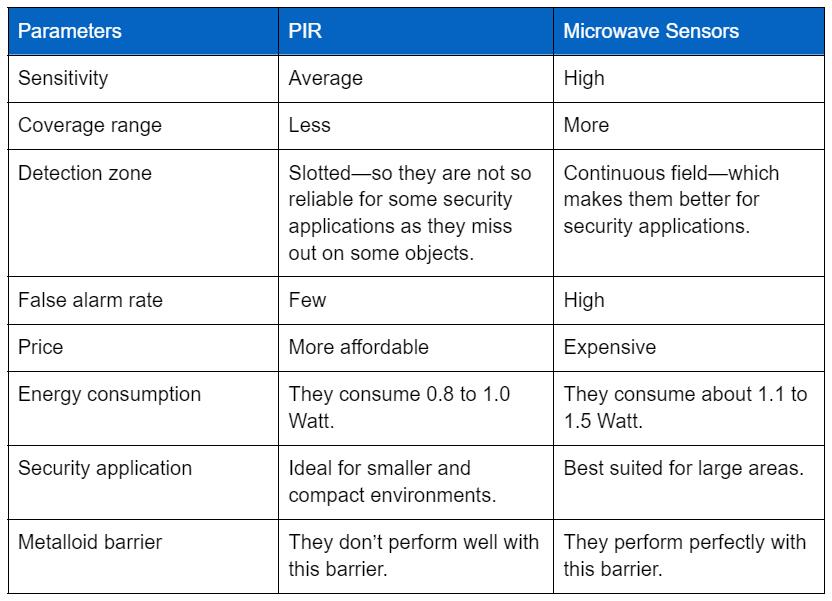Let’s face it! Security has become a thing of worry these days. Thus, motion sensors are one of the best ways to protect vulnerable points. Interestingly, the microwave sensor is one of the simplest motion ultrasonic sensors available.
Also, these sensors are invaluable to security. Why? Because of their effectiveness in differentiating intruders and average passersby.
This article will teach what microwave sensors are, the working principle, types, and many more.
If you’re ready, then let’s begin!
Contents
What Is a Microwave Sensor?

Motion sensors on doors
Indeed, a doppler radar or microwave sensor is an electronic device that uses electromagnetic radiation to spot movements like Crawling, Walking, and Running outdoors.
In truth, electromagnetic radiation consists of magnetic and magnetic fields. And these fields move at the speed of light.
But that’s not all. This sensor can recognize motion using the project microwaves and the doppler effect. These waves bounce off surfaces and go back to the sensor to trigger it.
In addition, this device measures echo time (the time it takes for signals to react to the sensor).
What’s Echo Time?
Indeed, echo time refers to measuring the difference between stationery objects within a field of the detection zone. As a result, the echo time creates a baseline that the motion detector uses for operation. In other words, the sensor needs echo time to spot any movement within the detection zone.
Types of Microwave Sensors
There are two major types of microwave sensors:
Active Microwave Sensors
The active sensors usually transmit radio signals toward a target, which spots the signal’s backscattered portion.

Microwave motion sensors with alarm
Also, the sensor measures the strength of the backscattered signal. How? By differentiating between the targets and the time delay between the signals. That said, the active sensors have two categories which are as follows:
Non-imaging Radar
Non-imaging radars are profiling devices that measure in one linear direction. Interestingly, these sensors include scatterometers and altimeters. Thus, the radar altimeters send out short microwave pulses. Plus, it measures the distance from sensors by gauging the round trip time delay to targets.
Indeed, the scatterometers are useful for making exact measurements (quantitative) of backscattered energy from targets.
Interestingly, scatterometry measurements can estimate wind speeds over ocean surfaces. Also, it can measure the backscatter energy on land from various targets of different surfaces and materials.
Imaging Radar
Unlike non-imaging radar, imaging radar records the intensity of the signal reflection. It also maps signal reflection in a two-dimensional image. Also, the radar images have many dots that represent the backscatter for a specific area.
Passive Microwave Sensors
In truth, these passive sensors have a long wavelength with small energy. Plus, the atmosphere can easily release them. Hence, they are characterized by low spatial resolution.
Also, they are useful for applications like;
- Measuring atmospheric profiles
- Determining ozone content
Only one type of sensor falls under this category: the microwave radiometer.
The Working Principle of Microwave Sensors
The microwave sensor works like radar. That is, it uses high-frequency radio waves working at 360 degrees. Then, the sensor emits waves that reflect on the receiver. Afterward, the receiver examines the waves that bounce back. As a result, microwave motion sensors tend to be either less sensitive or more sensitive.
Pros and Cons of Using a Microwave Sensor
Microwave sensors are resourceful, but they come with benefits and drawbacks. They include the following:
Pros
- The frequency of microwave sensors ranges from 0.3 to 300 GHz, ideal for non-broadcasting issues.
- They produce radiation in a specific region and spot any intrusion.
- Microwave sensors are helpful for various security devices.
- These sensors work perfectly in harsh environments with irregular heat cycles.
- The radiations can penetrate walls or holes and impart security across closings and boundaries.
- Prevents damage to the detector.
- It’s possible to program the detectors to reduce false alarms without decreasing correct positives.
Cons
- Microwave sensors may be expensive to run as they need continuous power draw.
- They work only at intervals rather than continuously.
- There’s a possibility of evading detection if the object runs fast enough.
Microwave Sensor Applications
The microwave sensors have a reliable performance in the following applications:
- Reverse car alarms
- Speed measure of vehicles
- Automated doors

Automated revolving doors were installed in the building
- Respiratory monitors
- Liquid level measurement
- Home security systems

Installed home security system with passcode
What’s the Difference Between PIR and Microwave Sensors?
The table below summarizes the difference between PIR and microwave sensors:

FAQs
What is a microwave radar sensor?
In truth, it’s an alternative to the regular proximity Infrared sensor. Also, it uses microwave Doppler radar technology to detect movements within a specific range.
What is a microwave proximity sensor?
Indeed, the microwave proximity radar sensor is the same as the microwave radar sensor.
What are microwave occupancy sensors?
Indeed, It’s a line voltage sensor that works based on occupancy. The device turns lights on and off based on objects it detects. Also, when the environment is bright, the sensors can hold lights off. In addition, the sensor functions via the Doppler principle and high-frequency electromagnetic waves.
Wrapping Up
In truth, a microwave sensor is worth considering for your home security. Also, the device is quite pricey compared to the PIR sensors.
So, before you go for this sensor, it’s vital to weigh your options. Also, you need to consider how often you’ll use the motion sensor, its sturdiness, and where you plan to install it.
Further, microwave sensors are best suited if you want a power-packed sensor in a large environment to detect movement effectively. So, do you want to get one or learn more about these sensors? Please feel free to contact us.





